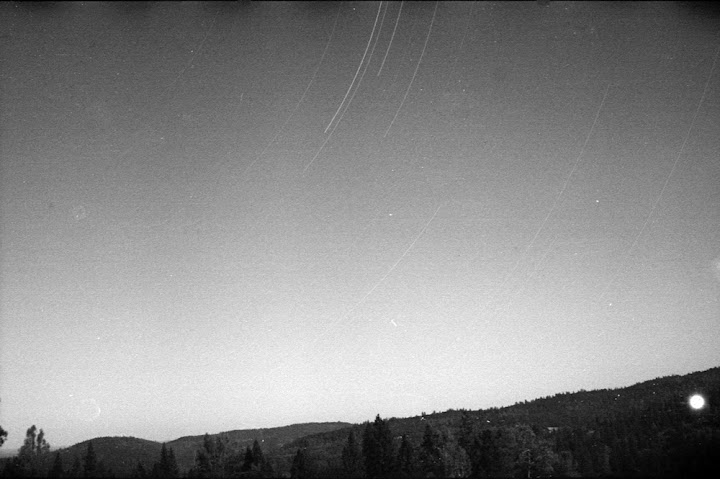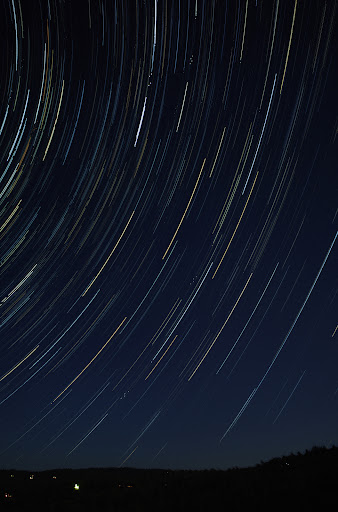Star trails have become a popular 'right-of-passage' type of photo for new photographers to attempt. They require some know-how and access to an area with minimal light pollution, however. So, living east of San Francisco, I can see about a dozen stars on a dark night. Capturing a star trail at home would not be feasible. Over July 4th, I was in Grass Valley, so I pulled an over-nighter and got 254 30-second images for my digital star trail. I also captured a film star trail. Here's the film image:

This was shot using 100 ISO Agfa film Next time, I'll try this with 400 ISO. The 100 exhibited poor star capture. It managed to capture the hills, though, because this was a four-hour exposure. Also, next time, I'll have a graduated neutral density filter to use to darken the lower landscape.
My camera for this was one of my Pentax K2 cameras with my Sigma 35-80mm, set at 35 and pointed north-ish. One risk of long exposures is light leaking onto the film through the eye piece, so I borrowed the eyepiece cover off my KM or K1000 (I forget which) and taped it in place so I wouldn't lose it. Then I remembered I needed to compose the image, so I took the cover off, composed the image, then re-placed it.
To prevent camera shake, I used a decently sturdy tripod and placed it in a protected area away from wind. This was the third and longest of my film images, taken after the moon set.
Taking a digital star trails image is a slightly different and requires multiple images. Digital sensors, unlike film, heat up and leave 'hot pixels' on the sensors after a while. Ultra-long exposures can also damage sensors, I've read, though I can't verify that empirically.
There are some pieces of gear you'll need:
1- A digital SLR or other digital camera with manual settings.
2- A sturdy tripod
3- An intervalometer (unless your camera has one built in.)
My Pentax K-7 has a built-in intervalometer for up to 99 images. As of this blog's writing, cheap, new intervalometers that allow up to 399 images can be purchased on eBay for $12-$20 (USD). This allows you to take hours of photos to capture things like star trails or experiment with stop motion.
I set my K-7 to 30-second exposures with five seconds in between. I should have left no more than two seconds in between as the five-second delay left gaps between the stars that were difficult to fix.

So this is the star trails image. Once I had the 254 images taken, I loaded them in Photoshop as a stack, auto-aligned them (which took hours and turned out not to be needed, since all the images were taken on a tripod-mounted camera. Then I had Photoshop blend the images. I experimented with various layering and blending methods, and arrived at the image above. Not hard, but time consuming.
Well, it's not 100% accurate to say I arrived at the image above. I had lots of little gaps between the stars, so I had to make a copy of the stars layer and rotate it. In order to rotate it, I had to do some geometry to calculate the rotational axis, which was WAAAAAAAAAAAY off the side of the image. I didn't get it quite right, so I needed up needing two layers (one for the outer rings and one for the inner.) You can see in the top middle where the two layers don't exactly align.
If you don't have Photoshop, there are a few free or inexpensive software options. Basically, if you have a decent tripod and decent DSLR (or entry-level DSLR and an intervalometer), you can make a star trails image. I do suggest Photoshop, though, as it allows you to remove the hot pixels that will show up on your image.
























































